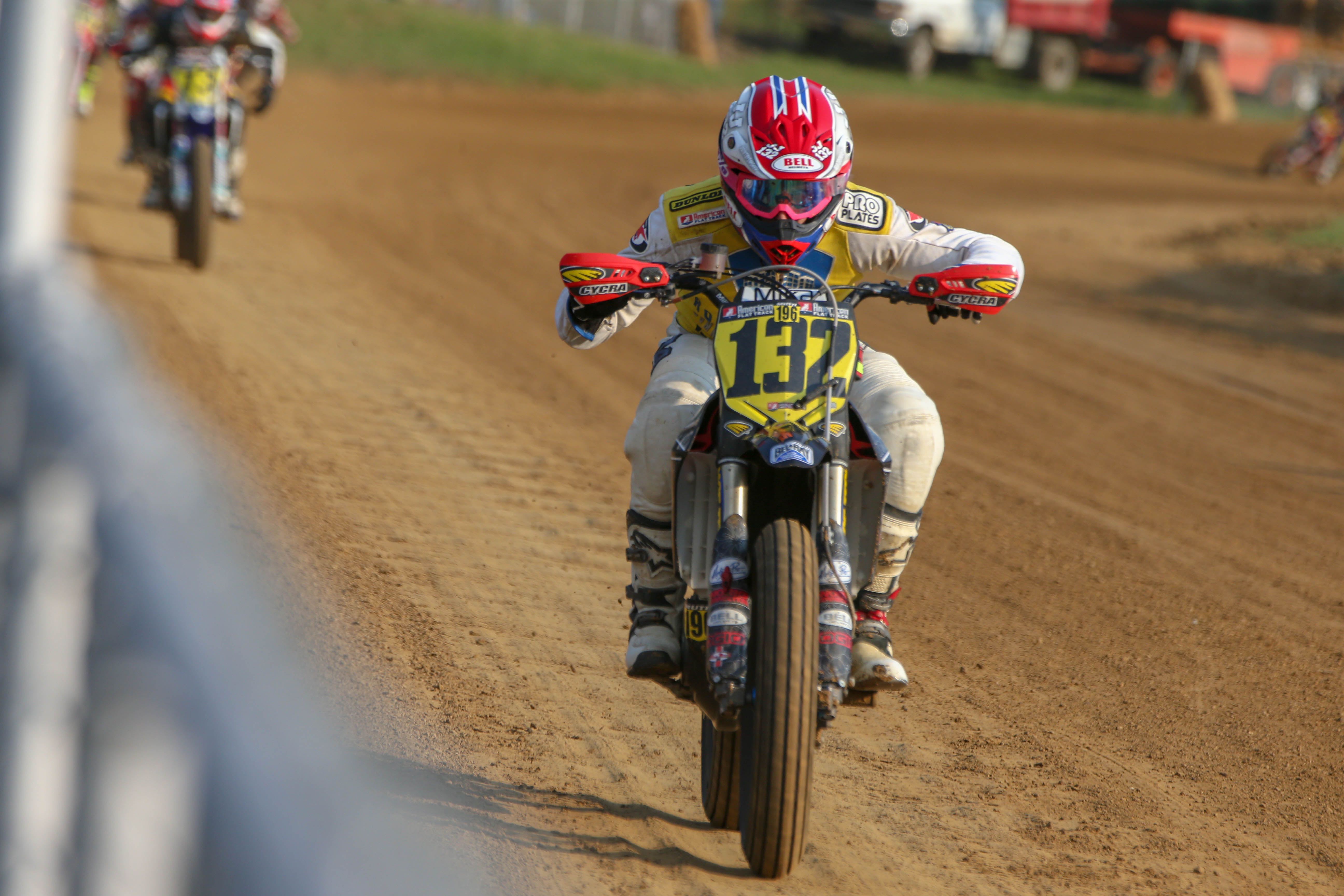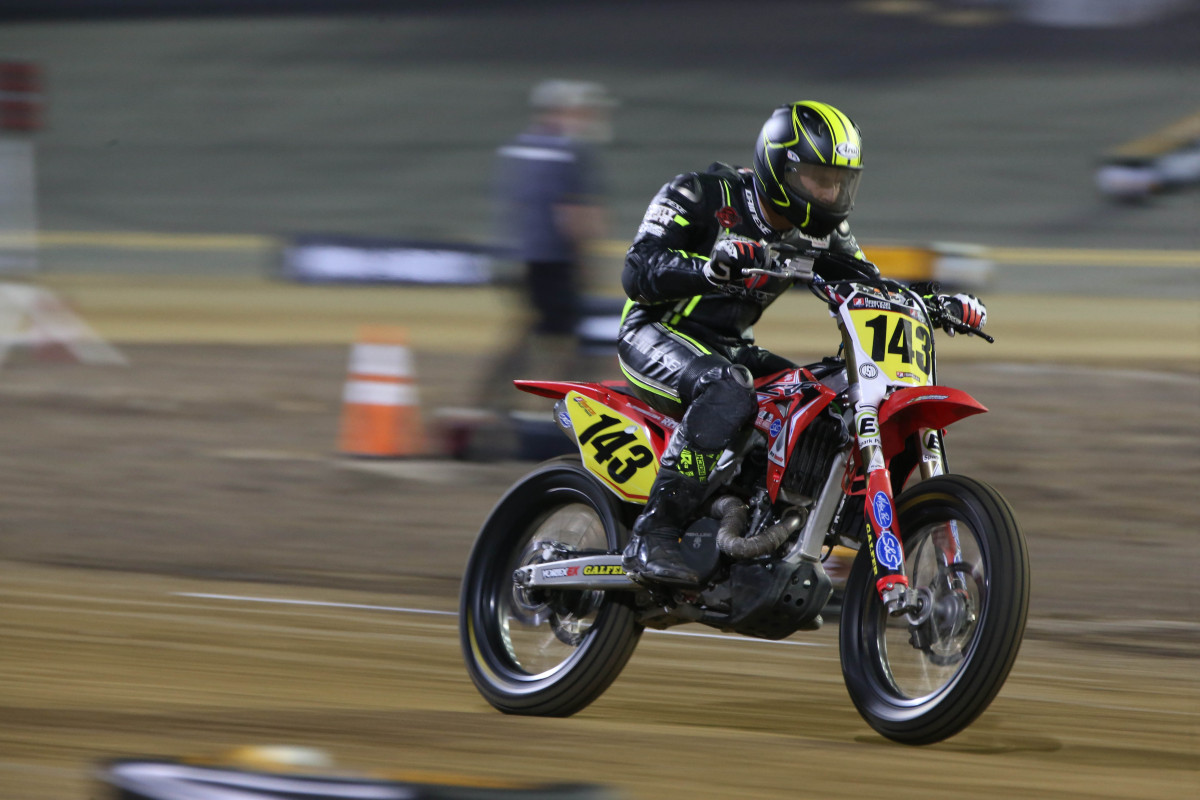Racing circuits change their rules from time to time, ostensibly to keep things competitive, address unforeseen loopholes, enhance the safety of the riders, address emerging or outdated technology, and many other reasons. While some teams might complain a little here and there, the rules changes are usually fair and don't serve to punish or reward any particular team or brand of motorcycle.
Most rule changes are minor - clarifications or subtle changes that don't matter too terribly much. Things like alterations in how many events last season qualifies a rider for a license or how eligibility is determined, that kind of thing. One change of note is that no rider licensed for Twins may compete in Singles next year, which seems a little spiteful. If somebody wants to race and has the appropriate motorcycle on which to do so, I say let 'em race!

Jared Mees after winning the 2018 Daytona TT on an Indian FTR750. Photo from MCNews.com.au.
Having said that, it's hard not to agree with Indian Motorcycle when they complain that one particular rule change for 2019 is an attack on the dominance their FTR750 race bike has shown in AFT for the last two seasons. Yes, yes, we have to admire the skills and capabilities of riders like Jared Mees and Bryan Smith (not to mention the upstart Bauman brothers). Let's look at what's going on.
Up until now we've gotten used to seeing 18 riders in the Main Event - that is, the race for the actual glory that follows the Semi-Final races. The top riders from each Semi advance to the Main, and bam! there's 18 bikes - three rows of six. The new rule for 2019 is that only 16 riders will compete in the Main - two rows of five and a row of six. This cuts two riders out of the Main - and AFT has given no explanation as of yet as to why they've made this change. It could cut down on the chaos that is the entry into Turn 1 on the first lap, but come on - they're all still going to charge down the straight and bang bars to be first out of that turn.
The new process will be sending the top 30 riders from Qualifying to the Heats. Each Heat will have 15 riders in it, with the top 12 going to the Semis. In the two Semis, those 12 riders will compete for the top eight slots to get into the Main. (This applies only when there are 26 or more entries for the Twins; under that, there's no Heat races. Over in Singles, that process is the same as Twins, unless there are more than 33 riders, in which case they add a Heat.)
One change I can't argue with is the adoption of full-face road-racing helmets for all classes. The motocross-style helmets look cool, but those protrusions on them can be dangerous in a crash at the speeds at which AFT races happen. Race-prepped full-face helmets are a great idea to enhance rider safety.
Some changes I don't understand include the new requirement that a rider check with a race official before manually - without tools - adjusting a clutch cable or brake lever. Not only must the race official approve the adjustment, but they must witness it as well. It seems petty and overly invasive to insist on a rider asking permission to adjust the clutch cable with their finger and thumb. Riders in the Production Twins class are now prohibited from using carbon fiber wheels, but they didn't change the wheel weight maximum of 40 pounds.
Another small change is the reduction of the minimum weight for a Singles bike from 235 to 230 pounds. This makes sense, as technology advances and metallurgical changes allow stronger components that weigh less. No clue why they didn't reduce the minimum for Twins down by five pounds as well.

Kenny Coolbeth, Jr. aboard a Harley-Davidson XR750 race bike. Photo from Cycle World.
Change that only affect Singles include the possible mandatory use of a Supermoto-style front fender, but the new rulebook says it is currently "being investigated," so it may or may not materialize before the season starts next March. One change that is not "being investigated" is the ban on using any kind of supplementary fuel injectors in this class. I guess that was a problem, so they needed a rule to ban it.
Now is when we get into the more significant changes. AFT has mandated a change from using Supreme 112 gas to GTX 260 Unleaded (both made by Sunoco), which has lower octane than the Supreme. Perhaps they're trying to maintain a cap on speed, because this will reduce power across the board. Still, it affects everybody equally, so no real complaint here. I'm sure the drop in power will be negligible when it comes to lap times - noticeable to the timekeeper but not to the fans.
Where we start to get into weird territory is the new engine rules. AFT will now allow engines up to 900cc - provided they come from a street-legal production model. Because it's racing, these "production" engines are allowed to be bored out to 900cc and tweaked by changing out the valves, pistons & conrods, cams and crankshafts. These changes will obviously continue to favor teams with factory support or those that have sponsors with deep pockets. It's a clear disadvantage to privateers who finance their own rides, but that's no real change over how things have been up to this point.
What it is, though, is a shot across Indian's bow. The FTR750 is not a street-legal production motorcycle, and everybody knows it. Indian built it as a race bike - you can buy one, sure, but you can't ride it on the street. For example, it allows riders on Kawasaki or Yamaha motorcycles to bore out their engines or fit larger-displacement engines into their race bikes, giving them a clear advantage over riders on Indian or Harley-Davidson 750cc motorcycles. It's not a horrible change, but it definitely singles out Indian and punishes them for dominating the podiums and season standings with a 750cc V-twin.

Jesse Janisch, AFT Singles racer, aboard his Yamaha YZ450F. Photo from American Flat Track.
(By the way, the rules have been changed to say that to qualify as a production engine, the engine must use the original crankcases or OEM replacements.)
What Indian is really complaining about, though, is a new rule allowing larger throttle bodies on - you guessed it - production engines. Anybody who can point to a street-legal bike with their engine in it can now use 40mm throttle bodies, while those who cannot are restricted to 38mm TBs. This gives a clear advantage to everybody not riding an Indian FTR750, especially at the Mile events, where those long straightaways let the riders get their bikes up to near full power.
In 2019, there are 18 races scheduled; six of them are on mile-long tracks. (There are four TT races and the remaining eight are half-mile tracks.) If the advantage is as significant as Indian is making it out to be, there's almost no point in Indian riders even bothering to show up to these six races.
What I don't like about these rule changes, especially the one that really only affects Indian, is that AFT is changing the rules to punish Indian for making a great race bike. Indian is justified to complain about it, and indeed, they sent out a press release earlier today to that effect. Race bikes are expensive, but that doesn't mean they shouldn't be purpose-built. Nobody is taking a stock Yamaha to the Peoria TT, after all. Teams with factory support will always fare better than privateers simply because they have the luxury of support, parts, money etc. from the source.
Of course, anything I have to say is mere speculation about how the rule changes will affect AFT races next season. Indian has a long time to get ready for the 2019 season - the Daytona TT isn't until March. If they're as resourceful as I think they are, they'll hit the track with rule-abiding bikes (and riders) that continue to outpace and outrace the competition.

 This move throws into contention which of BMW's current racers - Tom Sykes or Eugene Laverty - will take the remaining spot on the Shaun Muir/BMW WSBK team, and which rider will be the senior. Sykes, with six WSBK championship podiums to his name, is more likely to remain on the team over Laverty and to remain the senior rider as well.
This move throws into contention which of BMW's current racers - Tom Sykes or Eugene Laverty - will take the remaining spot on the Shaun Muir/BMW WSBK team, and which rider will be the senior. Sykes, with six WSBK championship podiums to his name, is more likely to remain on the team over Laverty and to remain the senior rider as well.
 Rebuild the forks, fresh tread, valve job, brake flush, you get the idea – but I’m lost in every corner, zero confidence. Somewhere I picked up bag full of bad habits. I looked into a rider safety class in my area but last minute it gets canceled. Blackhawk Farms Raceway is 1.5 hours south and they have a beginners’ class.
Rebuild the forks, fresh tread, valve job, brake flush, you get the idea – but I’m lost in every corner, zero confidence. Somewhere I picked up bag full of bad habits. I looked into a rider safety class in my area but last minute it gets canceled. Blackhawk Farms Raceway is 1.5 hours south and they have a beginners’ class.
 In one of the earlier sessions they want you to not shift gears. Let’s say third gear is the sweet spot you use that around the whole track. It’s a great experience going around the track trying not to touch your brakes and using only your engine for braking power. You learn to trust your front tire to do its job, which builds confidence.
In one of the earlier sessions they want you to not shift gears. Let’s say third gear is the sweet spot you use that around the whole track. It’s a great experience going around the track trying not to touch your brakes and using only your engine for braking power. You learn to trust your front tire to do its job, which builds confidence.
 You'd be forgiven if you didn't recognize
You'd be forgiven if you didn't recognize 

